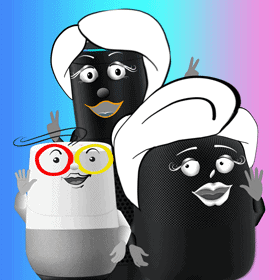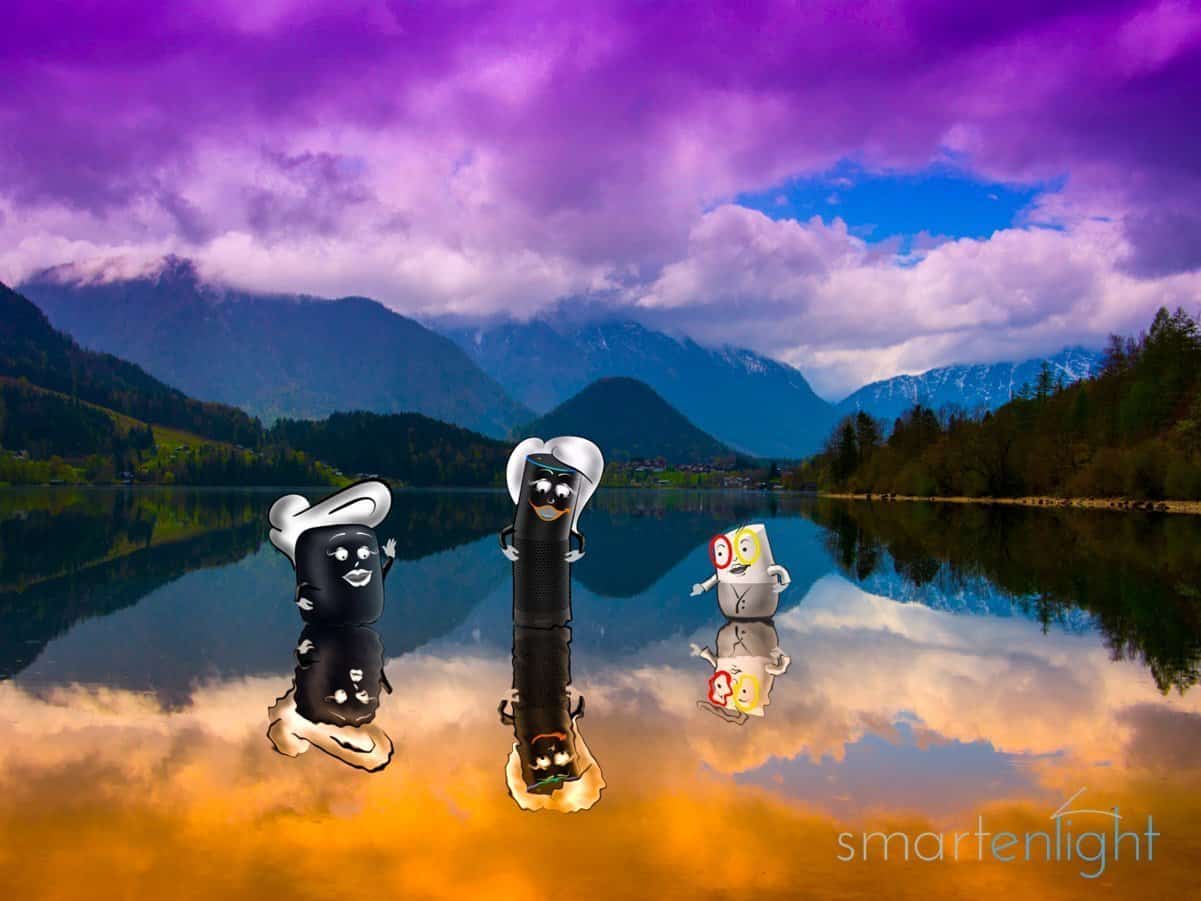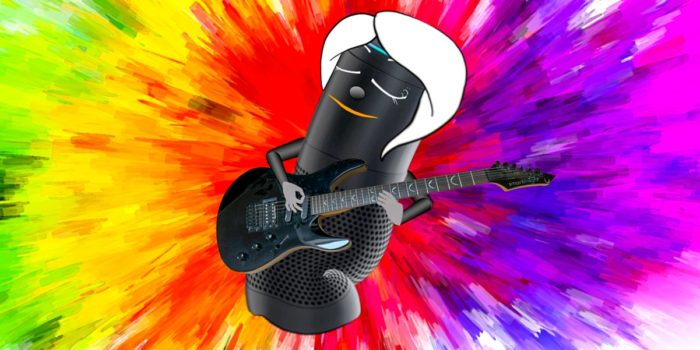Let’s examine the strengths and weaknesses of Siri, Alexa, and Google by comparing their configuration options, voice commands, and smart home features for our Philips Hue lights.
The world leader in lighting and the smart assistants of the biggest tech companies, can it get more “smart home” exciting than this? Have the past two years brought Alexa and Google the updates to catch up, or even overtake Siri and HomeKit?
This, of course, depends on the features which matter to you. While we can find many functionalities equally supported, we will also see some surprising Siri, Alexa and Google unique feats.
For our Philips Hue Setup post, please see: Philips Hue: A Smarter Setup for Your Smart Lights.
If you are interested in the setup and voice commands of a particular voice assistant with Philips Hue, you can find the posts here:
- Siri and Philips Hue: HomeKit Setup, Voice Commands, and Siri Shortcuts
- Alexa and Philips Hue: Setup and Voice Commands
- Google Home and Philips Hue: Setup and Voice Commands
Estimated reading time: 11 minutes
Comparing Siri, Alexa, and Google
Before we begin, let’s not forget that we are comparing features which are mostly provided through cloud services and therefore can break, change and improve silently overnight.
Mobile Hint: tilt your smartphone for a better table view!
| Apple HomeKit and Siri | Amazon Alexa | Google Home | |
|---|---|---|---|
| Configuration: Supports smaller setups (No Philips Hue Bridge) | NO | YES | Soon |
| Configuration: Supports larger setups (Multiple Philips Hue bridges) | YES | NO (third party) | YES |
| Configuration: Import Philips Hue Rooms | YES | YES | YES |
| Configuration: Import Philips Hue Scenes | NO: You need to create the scenes for HomeKit in the Philips Hue App. | YES | YES |
| Configuration: Imports Philips Hue Zones | NO | PARTIALLY (only scenes) | PARTIALLY (only scenes) |
| Voice Commands for turning lights ON / OFF | YES | YES | YES |
| Voice Commands for setting scenes | YES | YES | YES |
| Voice Commands for setting the brightness | YES | YES | YES |
| Voice Commands for setting colors | YES, extensive color set | YES, basic color set | YES, extensive color set |
| Voice Commands for color temperature | NO | YES | YES |
| Assistant Feature: Rooms and Groups | YES: HomeKit supports grouping devices to behave like a single device, grouping devices into rooms and creating zones | YES: Alexa supports grouping devices into rooms and Smart Home Groups | PARTIALLY: Google supports grouping devices into rooms. |
| Assistant Feature: Combining Scenes | YES, using Siri Shortcuts | YES | PARTIALLY (through routines) |
| Assistant Feature: Scheduling Scenes | YES | YES | PARTIALLY (through Routines, no sunset/sunrise) |
| Assistant Feature: Combining Scenes and Music | YES, using Siri Shortcuts | YES, using Routines | YES, using Routines |
| Assistant Feature: Gentle Wake and Sleep | NO | PARTIALLY (Hue Labs) | YES |
| Assistant Feature: Support of Philips Hue Accessories (Dimmer, Tap, Motion Sensor) | YES | NO | NO |
| Assistant Feature: Room Awareness | YES | YES | YES |
| Interactive Smart Display Support | NO | PARTIALLY | YES |
| Assistant Feature: Additional Automations | YES: You can define automations in the Apple Home app based on: - When people arrive - When people leave - An accessory is controlled - A sensor detects something | YES: You can define following triggers for Routines: - locations - limited set of sensors - pressing an Echo Button - deactivating the Alarm | NO, However, Google's bi-lingual smart home support is unique. |
Note, for an extensive list of voice commands, please see the dedicated assistant posts above.
How to draw our conclusions?
Having a favorite smart voice assistant is a matter of personal taste. Independent of their technical features and different approaches, I’m sure, you have your own reasons why you prefer one assistants company to another. Here, however, we will compare the current status of their smart home features.
Configuration Options
With the new Philips Hue Bluetooth bulbs, it makes sense to also look into the smaller setups which do not require a Philips Hue bridge. The Amazon Echo Dot (3rd Gen) can already make use of the new Bluetooth option, while the ‘Hubs’ Echo Plus and Echo Show (2nd Gen) already talk to Hue Bulbs through ZigBee. Google support will come soon and there is currently no way to control Philips Hue lights with Siri, without a Philips Hue bridge.
If you, however, have multiple Hue bridges, you might prefer Siri. Every Hue bridge is a separate HomeKit accessory, importing all your lights and rooms.
Alexa and Google are struggling with the concept of supporting only one skill/action per smart home manufacturer and we can only link a single Hue bridge to them. With Google, we can at least use the “household” feature to invite household members to share a Philips Hue bridge. Alexa would only support multiple Hue bridges through multiple Amazon accounts or third-party cloud services. But dividing and over-complicating our smart home is not what we are looking for.
Siri demands a high configuration effort, we need to create each and every HomeKit scene. Alexa and Google import every scene from the Philips Hue app, making them available for voice commands and automation.
Alexa and Google only partially support the Philips Hue Zones (beta). Currently, only the Zone scenes are imported, leaving us without the essential on/off, dimming and color features. Siri currently completely ignores this feature, she has her own Zones support. Still, we need to recreate Zones and Zone scenes in HomeKit, currently without any help from the Philips Hue app.
Voice Commands
It’s unusual to see so many “YES” in our table, and it was not always like that. Of course, we can turn our Philips Hue lights on and off with our assistant. But we can also equally set scenes and change the brightness. Color support appears a bit limited with Alexa, and Siri is lacking direct color temperature support (Kelvin), but here we could workaround with Philips Hue scenes as Philips recommends.
Assistant Features
Here’s where we can find the biggest differences. History explains why: Apple introduced HomeKit already in 2014, when Amazon just announced its Echo, initially with very basic smart home skills. Google Home joined in 2016 and both are quickly catching up in features, while HomeKit appears rather stagnating.
Two years ago, it was pretty clear. But now?
Rooms and Groups
Though we have a “Yes” for Siri and Alexa and a “Partially” for Google, these basic smart home concepts are implemented differently.
HomeKit & Siri support grouping smart home devices to behave like one. This makes sense for devices which only support basic features like on / off or dimming. For more complex settings we would anyway use HomeKit scenes. One device can only be added to one room. Additionally, we can define HomeKit Zones, e.g. for downstairs, upstairs.
Alexa supports grouping smart home devices into rooms. Additionally, we can group devices with Alexa’s Smart Home Groups, which gives us a lot of flexibility as one device can be added to multiple groups. A dining area or open kitchen in the living room, downstairs, upstairs, outdoors, with Alexa: no problem.
Google supports only rooms, and as one device can only be added to one room, we have the biggest limitations here. There is a – rather implicit – grouping concept: if you’ve named some lights the same way, e.g. “Ceiling 1, Ceiling 2, …” you can control your “ceiling” lights as group. But like with every implicit feature, this might rather confuse than help. If you want to group lights into other segments than rooms, you’ll need to create routines. As routines are personal, you’d need to recreate your routines for every family member, if you are using Voice Match and multiple accounts.
Note, Philips Hue Zones will help us here, once they are fully implemented for the voice assistants. But this will then only apply to Philips Hue lights and won’t help us if we are mixing with smart lights of other manufacturers.
Combining Scenes
Siri allows us to reference HomeKit scenes from automations, we cannot create scenes to activate other scenes in Apple’s Home app. But, we can create Siri Shortcuts to activate multiple HomeKit scenes with just one voice command.
Alexa supports Smart Home Groups, which can not only contain smart home devices, but also smart home scenes.
Google, only supports combining scenes with Routines, which feels like a limitation in a multi-person household, when using personalized results and VoiceMatch.
Note, Philips Hue Zones might help us here, once they are fully implemented for the voice assistants, but only for Philips Hue lights.
Scheduling Scenes
Philips Hue supports custom scheduled routines with many different options in the Philips Hue app. However, if we want to schedule our Philips Hue lights together with other smart home devices, we need to check the scheduling support of our assistants.
Siri, Google and Alexa support schedules at a time of the day. Siri (since forever) and Alexa (since today), support sunrise and sunset timers, with offsets to trigger scenes a specified time before or after.
With Siri’s HomeKit, we can additionally define if the schedules should be triggered only if somebody is at home. Quite powerful, but only if every family member owns an iPhone. Google has still no clue about sunrise and sunset.
Combining Scenes and Music
Apple HomeKit lacks music support. We need Apple’s Shortcuts app, to create Siri Shortcuts, which can activate HomeKit scenes and play our favorite music.
Google and Alexa have a ton of features integrated through their routines. Playing music and setting scenes are an integral part thereof.
Gentle Wake and Sleep
We cannot naturally dim and brighten smart lights with Siri and HomeKit. For this, we need to create routines in the Philips Hue app or a Hue third-party app.
Alexa provides voice commands for the equivalent Hue Labs formulas.
With Google, however, Philips took the effort and implemented the “Gentle Wake and Sleep” features directly into the assistant with dedicated voice commands.
Supporting Philips Hue Accessories
It’s only Apple’s HomeKit which supports our Philips Hue Dimmer, Taps and Motion Sensors as HomeKit accessories. This makes it possible to control also other HomeKit devices from other manufacturers with our Philips Hue accessories.
Room Awareness
All three speakers, when assigned to a room, will accept short commands where we don’t need to specify the room and can control the smart devices of this room only.
Interactive Smart Display Support
Comparing an iPad running the Apple Home app to an Amazon Echo Show and a Google Nest Hub, we see following differences:
The Echo Show lists our Smart Home Groups and individual devices in the “Lights and More” section. The Google Nest Hub “Lights” section additionally opens a detailed room view where we can control brightness, color and individual lights. With the Apple Home app we can activate and deactivate scenes per room and control our HomeKit accessories individually or in groups.
When we use Siri to control the lights, she’ll take up the whole iPad screen, covering any open application. She disappears after a couple of seconds and we only see the changes of our accessories/scenes reflected in the Apple Home app. The app won’t automatically switch to the room we have controlled with voice, offering additional settings. On an Echo Show, a dimmer and on/off buttons for the room we have controlled will appear. Google on the Google Nest Hub will open detailed light settings, allowing to control brightness, color and individual lights with a mixed voice & touch experience.
Note, Amazon has already announced that they will update their smart home control section when releasing their Echo Show 5 later this month. Apple’s iOS 13, which will be released later this fall, will bring many updates to the Apple Home app. However, in its initial release it will not fix Siri covering the whole screen (acc. to Apple’s VP of Software). We will retest once the iOS public beta is available in July.
Additional Automations
Finally, let’s check what other automation options Siri, Alexa, and Google provide us to control our Philips Hue lights:
HomeKit leads the pack with location-based automation, using the changing state of devices as the trigger (e.g. when you turn a light on) and supporting sensors, like motion or contact sensors, smoke detectors, or security/occupancy sensors. There are many HomeKit remotes, one of them the Nanoleaf Remote, with which you can control your HomeKit devices and scenes.
Alexa supports location-based automation, a limited set of sensors, Echo Buttons as remotes and more recently the action of deactivating your morning alarm to trigger Alexa Routines.
Google currently lacks all of that. However, Google shines with a feature, which is unique: You can talk to your Philips Hue lights in two languages, at once. So if you’re a bi-lingual household, you might find this feature quite helpful.
Conclusion
Philips Hue has solid integrations with all three voice assistants.
Bridgeless setups with limited functionality are currently only supported by Alexa, with Google coming soon. It would be nice to see Siri Shortcuts in the new Philips Hue Bluetooth app.
For basic setups with one bridge, you will find the Philips Hue lights equally well supported by Siri, Alexa, and Google.
It’s only with more complex setups, where we can find differences and missing features. And they are not always on the Philips Hue side, but rather reflect the current state of smart home features supported by the voice assistants.
Wrap-Up
Siri’s HomeKit is quite extensive but basically hasn’t changed a lot since it’s initial introduction in 2014.
Google has a rigid room structure and location ignorance. The latter appears humble given how data hungry Android smartphones are. Anyway, Google’s bi-lingual support is amazing and unique!
Google leads currently with interactive smart display features, offering a mixed voice & touch experience. Google doesn’t support sunrise and sunset automation, Alexa only as of today. Alexa additionally supports location-based routines.
If we look into the supported sensors and remotes, there’s hardly anything outside of Amazons and Alphabets ecosystem that we can integrate without the help of 3rd party smart home hubs or 3rd party cloud services. But given the speed of this catch-up game, we can expect that most of the smart home features will level out rather sooner than later.
Outlook
We saved the best for last: What happens if your Internet goes down?
HomeKit will still run your smart home automations from your HomeKit Hub (iPad, AppleTV or HomePod) and control your Philips Hue lights. “Hey Siri” won’t work offline.
Alexa and Google routines won’t run, currently requiring being constantly online. And you currently also cannot invoke “Alexa” and “Hey Google” without internet.
Google has recently announced to work with selected vendors (including Philips Hue) on a Local Home SDK, which will perform smart home commands faster by executing them locally. Google also recently started to support local recognition of the command “Stop” to stop a timer or alarm, without having to say “Hey Google”. And a key theme of Google I/O 2019, was the breakthrough to shrink the Assistants AI so that it can run locally, on device.
Amazon provides a ZigBee Hub built into selected devices (Echo Plus, Show 2nd Gen.), but with reduced functionality compared to a Hue Bridge. “Local Voice Control” is available as a setting on those selected devices, but hardly functional (“I am having trouble connecting right now …”). Amazon already announced last year improvements in shrinking Alexa’s AI models to run locally, presumably first targeting the Echo Auto.
What we can extract from the above, are quite interesting questions for Siri, Alexa, and Google:
- When will Alexa and Google provide local smart home automation?
- Who will first support local recognition of smart home voice commands?
- How will these concepts tie into privacy and security, as pioneered by Siri since HomeKit release?
Interesting times ahead!
If you have questions or feedback – maybe we’ve overlooked some features – please leave your comment below. You can subscribe to receive notifications when we’re updating this post.
Happy Hue with Siri, Alexa and Google!
P.S.
- If you’d like to read more about Siri, see: Apple Siri.
- For more Alexa posts, check out Amazon Alexa.
- More Google Home posts are here: Google Assistant.






Added “Configuration: Supports smaller setups (No Philips Hue Bridge)”.
Added the “Interactive Smart Display Support” section.